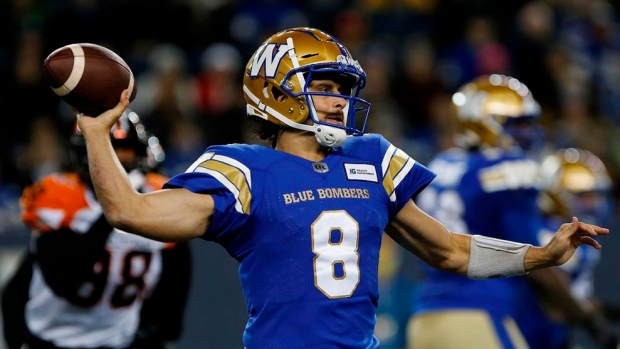Jan 12, 2022
Collaros contract could get complicated for champs
The Blue Bombers have a boatload of high-quality potential free agents they want to keep but every dollar they pay their quarterback makes that more difficult to do, Dave Naylor writes.
By Dave Naylor

As a pending free-agent quarterback this off-season, Zach Collaros is either in a great or tough situation.
It all depends how you look at it.
On one hand, he’s bargaining from absolute position of strength, given what he’s delivered to Winnipeg since being traded there in October of 2019.
Besides leading the Blue Bombers to back-to-back Grey Cup wins, Collaros has a record of 16-1 as Winnipeg’s starter (excluding games where the team had clinched first place and rested players).
He is coming off a season in which he was named the regular season’s Most Outstanding Player and MVP of the Grey Cup.
The problem is that the Bombers have a boatload of high-quality potential free agents they would like to keep, and every dollar they pay Collaros makes that harder to do.
So, what’s a fair contract for both sides here?
To answer that we must look at the overall context of the CFL’s quarterback market, which has undergone a correction over the past 12 months – at least at the very top end.
The league’s quarterback pay scale remained fairly consistent from the early 2000s through to 2018, with the best players compensated mostly in the $400,000-$500,000 range, with few exceptions.
Even during an era that featured the prime years of such players such as Ricky Ray, Anthony Calvillo, Dave Dickenson and Darian Durant, the ceiling never got shattered.
That didn’t happen until after the 2018 season, when quarterbacks Michael Reilly, Bo Levi Mitchell and Trevor Harris all went to market as free agents at the same time.
The driving force was Reilly, who at age 33 had led the CFL in passing for three consecutive seasons, a string that began the year after he led Edmonton to a Grey Cup victory.
When Edmonton and B.C. stopped bidding for his services, Reilly had a four-year $2.9 million dollar contract to play just a short drive from his Seattle home.
That deal immediately put pressure on the Calgary Stampeders, where Mitchell was in a dance with the Toronto Argonauts, who were waving the figure of $900,000 per season.
Mitchell didn’t bite but did manage to leverage $700,000 per season over four years from the Stamps, putting another leg under the league’s new upper-tier salary table.
Harris, never the best quarterback in the CFL at any point in his career, cashed in that same off-season for $550,000 per season as Reilly’s replacement in Edmonton.
Twelve months later, Calgary’s Nick Arbuckle, a player with just seven starts in his CFL career, signed with Ottawa for a deal worth as much as $450,000 per season, which used to be upper-tier quarterback money.
But there has been a correction at the top end as none of Reilly, Mitchell nor Harris have been able to sustain a level of play that justifies the contracts they signed after 2018.
Reilly, who played for $525,000 last season after having his contract restructured, is believed to be considering retirement. (It’s widely believed that the Lions, who missed the playoffs with Reilly for the second consecutive season, won’t pick up his option at its current value of $575,000 for 2022.)
Mitchell recently re-did his deal to a base of $425,000 for 2022, making room for a raise for backup quarterback Jake Maier.
Harris, meanwhile, is a free agent following his release by Montreal, which had acquired him via trade from Edmonton in October. He still has value in the CFL but his days of making a marquee salary appear to be over.
Also driving the market down is the rash of quarterback injuries over the past two seasons, demonstrating the value of teams spending money on both their offensive lines and quality backups.
The CFL’s defensive direction over the past few seasons also means fewer quarterbacks with the gaudy statistics that justify mega contracts.
That includes Saskatchewan’s Cody Fajardo, who has the league’s highest salary for 2022 at $515,000 despite throwing just 14 touchdown passes against 11 interceptions in 13 games last season.
That deal has implications for all quarterbacks still needing to sign for this season, especially Hamilton’s duo of Jeremiah Masoli and Dane Evans – only one of whom is expected to remain with the Tiger-Cats.
Unless the Roughriders decide to renegotiate Fajardo’s salary down for this season, Collaros’ deal must come in above $515,000, which is a healthy bump from the $410,000 he earned during his 2021 MOP season.
Given what an ideal fit Collaros has been in Winnipeg, there’s every reason to think this will get worked out. In doing so, Collaros will establish a new ceiling for quarterback compensation, likely somewhere in the $550,000 range.
It just may take a while to get there.

